Hairballs, Not So Funny
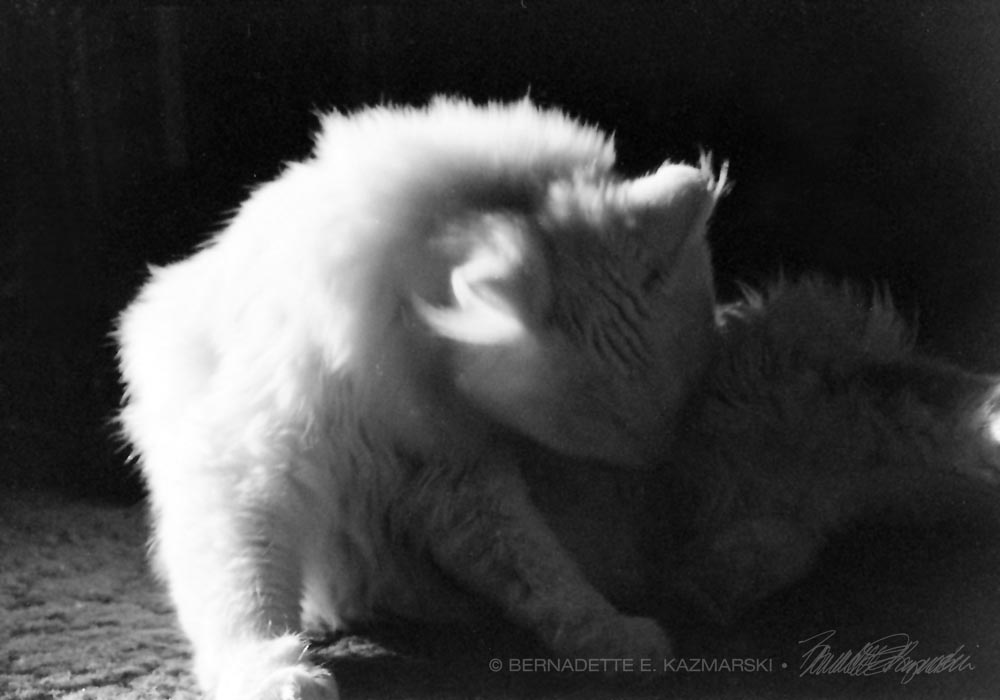
The last Friday in April is honorarily Hairball Awareness Day, and before you either yawn and click somewhere else or have a laugh at what seems like a good joke, read on a bit.
I remember reading in a Q&A in a cat care newsletter years ago, “Why Do Cats Throw Up?” The answer began, “There are so many reasons cat throw up it’s pointless to try to figure it out,” and listed the main cause as “hairball”. Truly, 15 or 20 years ago, that was the prevailing opinion, and cleaning up after cats was and often still is the butt of many jokes, and hairballs are still not considered a reason for alarm. A little bit of PetroLax or even just plain petroleum jelly would get things going.
But when a couple of years ago I began reading about causes for hairballs in addition to excessive fur intake, such as the content of a cat’s food and the state of the cat’s gastro-intestinal tract and how it managed hair, what I read made sense with what I had traditionally observed, and what I was observing at the time. Until recently I had to pack things away completely, all my art supplies, fabrics, clothing, stuff on my desk, you name it, or there would be a hairball mixed in with it sooner rather than later, especially when I lived with nine or ten cats. The ones that didn’t end up on my work surfaces I found under my bed, in corners, behind furniture, even in the litter box. Even with regularly brushing them, several times a week I’d hear the old familiar hacking noise and run to find what piece of mat board or bedspread they were going to deposit on.
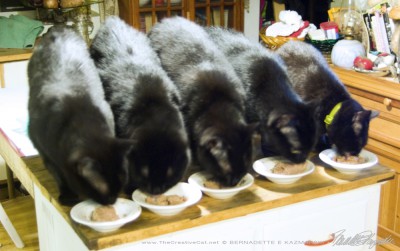
Now that the Five are on a completely raw diet with occasional canned food I so rarely have a hairball that, until Mimi began bringing them up in the past year, I honestly couldn’t remember the last time I heard them or found one where before the raw diet they were just as frequently tossing them up as any other cat ever had. Diet does play a very important role, and not just for what happens in the stomach with loose fur, but for what happens on the skin and the health of that fur. I still have to brush, especially at this time of year.
When a hairball is not just a hairball
In truth, both vomiting and producing hairballs are reasons to be concerned. Vomiting should always be investigated by tracking what and when and how often and any changes in your cat’s eating or elimination habits, and reporting this to your veterinarian. An occasional hairball isn’t really a reason for concern, but regular production of them is often a clue to deeper issues, and often just vomiting up a hairball itself can be dangerous to a cat’s health with damage to the esophagus or mouth, a possibility of inhaling fluids into the lungs, choking, and in cats who have other respiratory or cardiac conditions it can even worsen the condition or lead to death.
The connection with Inflammatory Bowel Disease (IBD)
When Mimi began bringing up hairballs last year I knew something was wrong. First, this was new, and any change in digestion is always a warning to be noticed and tracked. Second, I had been reading for the past few years that cats forming hairballs is not typical to their species at all and was an indication of the state of their gastrointestinal system. If cats living in the wild had been in the habit of yarking up hairballs all the time with all the associated dangers to nutrition and to body health the species would not have survived at the rate it has. Cats naturally digest the hair they take in from grooming, and the fact it gets stuck and forms a ball shows that hydration, gut bacteria, intestinal tissues and other aspects of her gut are not normal. Mimi had had other bowel issues in her history, not diarrhea as expected but constipation and dry hard stool. When she began eating less and less and then quit eating three weeks ago I knew it was serious and had an idea what we’d be looking for. After this round of prednisone and antibiotics she will go back for blood tests and an ultrasound. If necessary she will have an intestinal biopsy. I’m not willing to wait until she possibly develops lymphoma to start testing and treatments.
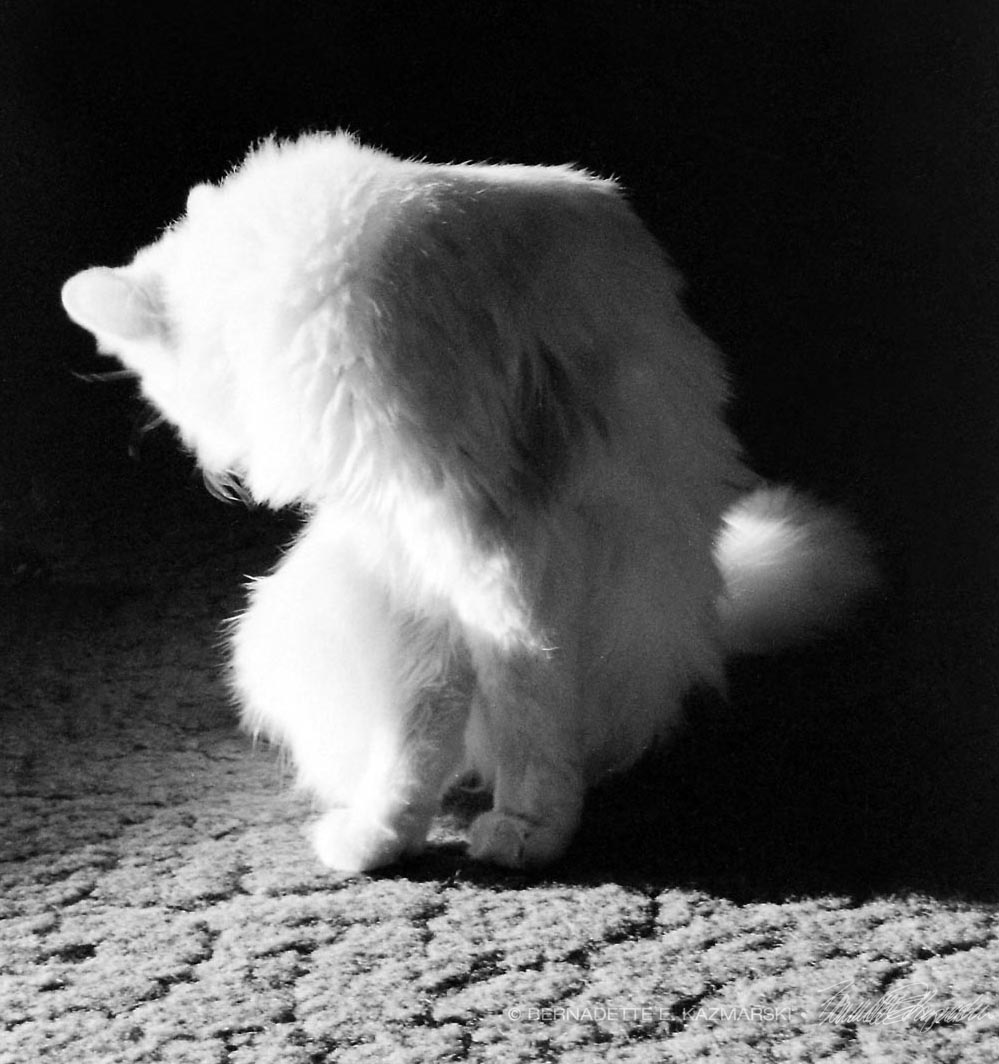
Damage to teeth
My lovely long-haired Sally cat, top, produced hairballs nearly daily and vomited on a professional basis, always finding the spot from which she could spew on the greatest area and number of hard-to-clean objects. She hated being groomed or handled in any way, and developed huge knots on her sides and belly. I didn’t know anyone who could groom cats so I risked my life to clip away at them and brush the excess from her fur, but I know that no one really took Sally’s vomiting up hairballs very seriously including me. By her early teens her teeth were in such bad shape from the constant flow of stomach acid in her mouth that a few teeth fell out on their own, and even a cleaning couldn’t help the damage. She developed an infection in her sinuses that, through a subsequent dental cleaning, was traced to the loss of one of her canines and possibly stomach acid infiltrating her sinuses through the infected area. That condition continued through her last three years to a varying degree giving her constant sinus irritation and drainage. She ultimately developed a bony cancer in her jaw near where a tooth had fallen out, and though it’s hard to say if the vomiting from hairballs was a part of it, it likely contributed to it with constant small infections in her mouth.
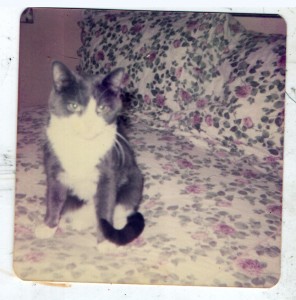
A cough isn’t always a hairball
A dry, hacking cough is often associated with a hairball, but this doesn’t mean that’s always what it is. My first cat, Bootsie, had a dry cough through most of her life at which everyone seemed to knowingly nod and say, “Hairballs,” and go on with their day, yet she rarely brought one up or seemed to have any issues at all with her fur. At about age 12 when the cough grew more persistent and prolonged, and occasionally her nose turned blue while she was coughing, even the vet nodded and said, “Probably hairballs,” advised Laxatone and gave me a prescription for prednisone if the coughing became too bad. It turned out Bootsie had had asthma all her life and this condition had turned to a condition similar to emphysema where here lung tissue had been damaged so badly her lungs had lost capacity, and a prolonged coughing spell turned into a severe asthmatic attack, a trip to the emergency hospital and an unfortunate euthanasia. We didn’t know that much about feline asthma at that time, but even today when we do understand feline asthma better I still hear people say, “That’s a hairball cough,” and not looking any further.
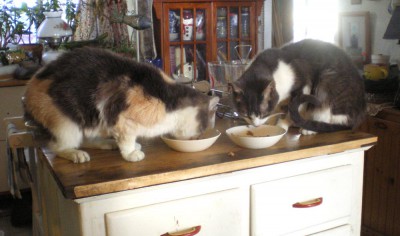
The importance of diet
Surely cats did not evolve being able to live while vomiting up hairballs on a regular basis. Sally was long-haired, and the difficulty of swallowing and passing her long fur was almost understandable, but at one time all my cats of all fur lengths and types tossed up hairballs. Sally and Bootsie both had tubes of hairball remedy and it didn’t help either one, and later special hairball-relief foods with extra fiber to keep the hairball for forming didn’t help the situation with other cats either.
Sweet little Peaches suffered from constipation and vomited at least once every day, sometimes producing a hairball and sometimes not. Chalk it up to age—she was 15 when she came to me and didn’t get any younger, but on an exam my veterinarian also noted that her intestines were very ropy and lumpy, “a mess” as she described them, indicative of irritable bowel syndrome. In working with her constipation and trying to heal her intestines, she also vomited less, gained weight and ate more easily.
The main difference between cats in the wild and our housecats is their diet. By “in the wild” I mean cats surviving on small prey eaten raw, not human leftovers. As I was working with Peaches I moved from what I’d felt was a premium diet but was not grain-free to one that was grain-free and all vomiting and hairballs slowly decreased. Continuing with the exploration of diets I moved step by step to where I now feed a raw diet as mentioned above rarely see a hairball. Occasionally one of them vomits but there’s nothing to it and it never happens a second time; I note that it happened and continue to observe.
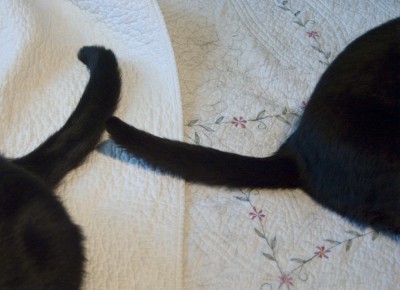
And even shedding is so far reduced that my typical white or light-colored bedspread where five black cats sleep each night and often each day has very little cat fur stuck to it, even after a month when I typically change the spread because it’s usually so covered with hair…and other things.
So hairballs are really not a laughing matter, and using laxatives and fiber may help in the short run, but don’t help over time. Looking at your cat’s diet and changing to a species-appropriate diet is the best treatment. Read Some Startling New Thoughts on Cats and Hairballs on The Conscious Cat for more information on how diet can make a difference.
Grooming
Of course, grooming your cat to remove the excess fur is something you should do on a regular basis. Not only does it remove the excess fur before they swallow it or it ends up on your furniture but it’s also a nice way to bond with your kitty.
Read more articles in the category Health and Welfare
Browse some rescued cats and kittens!
All images used on this site are copyrighted to Bernadette E. Kazmarski unless otherwise noted and may not be used without my written permission. Please ask if you are interested in using one in a print or internet publication. If you are interested in purchasing a print of this image or a product including this image, check my Etsy shop or Fine Art America profile to see if I have it available already. If you don’t find it there, visit Ordering Custom Artwork for more information on a custom greeting card, print or other item.
© 2015 | www.TheCreativeCat.net | Published by Bernadette E. Kazmarski
—
Weekly schedule of features:
Sunday: Essays, Pet Loss, Poetry, The Artist’s Life
Monday: Adoptable Cats, TNR & Shelters
Tuesday: Rescue Stories
Wednesday: Commissioned Portrait or Featured Artwork
Thursday: New Merchandise
Friday: Book Review, Health and Welfare, Advocacy
Saturday: Your Backyard Wildlife Habitat, Living Green With Pets, Creating With Cats
And sometimes, I just throw my hands in the air and have fun!
—




Thanks for such an informative post. I really need to look into a raw food diet for my cats.Every time Joanie eats too fast, she vomits.